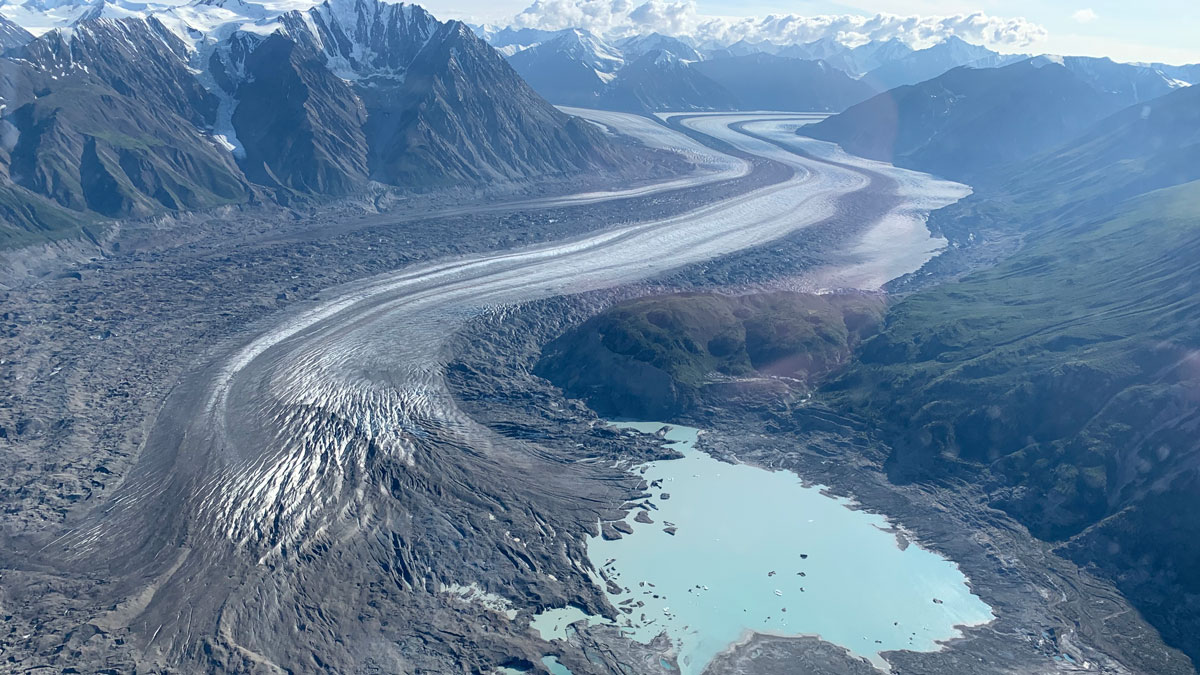At the feet of mountain glaciers, melting ice forms pools of water that can be trapped behind moraines. And with warming temperatures, these pools are surging in both size and number. In Alaska and northwestern Canada, 183 new lakes appeared between 1984 and 2019, covering 483 square kilometers (190 square miles).
“We kind of knew that there’s this interplay between glaciers and proglacial lakes, but we’re just scratching the surface of that understanding.”
New research showed that the presence of these proglacial lakes affects how quickly their parent glaciers retreat. Melting mountain glaciers are responsible for about a third of global sea level rise. Scientists need a better understanding of how the movement of glacial ice is going to change in a warming and potentially wetter world, said Brittany Main, a doctoral candidate in geography, environment, and geomatics at the University of Ottawa in Canada and lead author of the study.
“We kind of knew that there’s this interplay between glaciers and proglacial lakes, but we’re just scratching the surface of that understanding,” Main explained. To better understand the link, she and her colleagues examined 120 years of historical photographs and used satellite images, field visits, and air surveys of Kaskawulsh Glacier in Canada and the lakes found at its foot.
Ice in the Balance
“A really cool and novel aspect of this research is they can essentially use this lake drainage on Slims Lake as a natural experiment.”
Though researchers have had a hunch that a lake in front of a glacier likely affects velocity, finding locations to study the interaction has been difficult, Main said. Records show that between 1899 and 2020, the lakes below Kaskawulsh Glacier appeared, disappeared, and reappeared, providing a unique set of circumstances to address the problem. “We really got to watch it go through this cycle,” she said.
As the glacier retreated in the first half of the 20th century, two proglacial lakes formed. By the summer of 2015, one of them, Slims Lake, had grown to 3.7 square kilometers (1.4 square miles). But in the spring of 2016, it suddenly drained, its surface level falling by 17 meters (56 feet, or 30%). The toe of the glacier, which had been floating in the lake, dropped onto the sediment along the new shoreline. The researchers saw that the event slowed the glacier’s velocity by almost 50%—a big impact considering that only one of the glacier’s two proglacial lakes drained.

“A really cool and novel aspect of this research is they can essentially use this lake drainage on Slims Lake as a natural experiment,” said William Armstrong, a glaciologist at Appalachian State University who was not involved in the research. The ability to track the glacier-lake relationship over a long term allays concerns about unaccounted variables, he added.
The impacts of proglacial lakes on overall glacier health and the degree to which lakes might be driving ice loss in a warming climate remain unclear. “I think that’s still an open question about this glacier and the effect of these lakes as a whole,” Armstrong said.
Environmental Impacts Beyond the Glacier
The drainage of Slims Lake in 2016 brought local environmental repercussions as well. After the event, enormous dust storms blew through local communities almost every day because sediment once underwater had been exposed. The water in the lake that once flowed into the Ä’äy Chù (Slims River) was rerouted into the Kaskawulsh and Alsek rivers. That, in turn, affected ice stability, regional drainage, fish populations, and sediment transport.
As the climate warms and melting glaciers feed ever growing proglacial lakes, the risk of outbursts—caused by a failure in the lake wall—or rapid drainage increases. The 20th century saw a sixfold increase in glacial lake outburst floods, which can happen very quickly, killing people and destroying infrastructure and land. One estimate put 15 million people at risk of future outburst floods.
Less Stability
Kaskawulsh Glacier is also an inherently less stable glacier because some of it sits on a reverse slope—the bedrock underneath curves up toward the toe of the glacier like a skateboard ramp. The ice fills a deeper space farther upstream and is therefore thicker than it would be on a normal slope. That, in turn, means that as the glacier retreats, more ice is exposed than would be on a normal slope. Kaskawulsh Glacier is likely to retreat farther, and proglacial lakes will continue forming, Main said. That might drive more melting, although, she said, many reverse slope theories still need more data and modeling.
Kaskawulsh is retreating slower—22 meters (70 feet) annually—than other lake terminating glaciers in Alaska and the Yukon, Armstrong said. The median retreat rate, he explained, is 60 meters (200 feet) per year—almost 3 times faster. Kaskawulsh may therefore not be an extreme example of this lake-glacier feedback in the region. “There are many lake-terminating glaciers that are retreating much faster than Kaskawulsh, suggesting that their proglacial lakes could be more destabilizing,” he said.
This research showed that we need to think of glaciers holistically and not as structures in isolation, Main said. “We have things all along the edges, and they’re really difficult to include in studies,” she said. “This study is just like one small example of trying to do that.”
—Danielle Beurteaux (@daniellebeurt), Science Writer
10 March 2023: This article has been updated to clarify the glacier’s movement.

